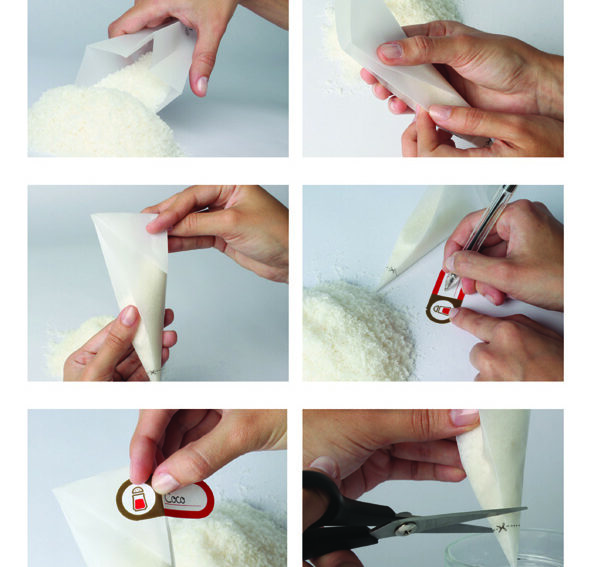On February 1, 2012 the Liderpack Jury granted an award to the best Spanish packagings. The most refreshing category was “Young Design”, consisting of junior creative proposals. One of them was a pack for spices sold loose. It was compact, small and practical, developed by Carolina Caycedo, a student at Elisava School.
We not only acknowledged its style (it was a contemporary revival of the paper cones made by the typical spice stallholders) but also its practicality (it could be opened and closed after use). We valued it because it answered current shopping trends: buying loose.
Let’s reflect on 6 aspects that all packagings should comply with:
The packaging represents a customer promise. It is like an “imagination shuttle”, for it allows consumers to feel in advance all the sensations and satisfaction the product will convey (1). In other words, the packaging is one of the best means to express the brand sense, especially if done in an implicit and intuitive way.
Due to the power of pack designs, executives are advised to withhold from overstating their promise, that is, from evoking more expectations in consumers than what reality has to offer. Tempting as that may be, customers would feel frustrated and ultimately, deceived.
In pharmaceutical jargon, galenic innovation is that which innovates not the product itself, but its applications by making them easier, faster or more convenient to use.
This point is of particular relevance to packaging: a customer-centric approach translates in more product functionality, be it while buying it or using it. The easy-open is a clear example of galenic innovation.
Over time there have been great developments in this area, even in material packs for factory assembly lines.
Information shouldn’t be looked down on, no matter how obvious. Without facts, a product cannot be compared. The info is all the product has to say about itself: in writing, visually and by any other element, that could be semiotically analysed.
Science has made some promising progress in packagings by making them smart. They can now indicate the status of their contents, like for instance, if there has been a break in the cold chain.
Another aspect that shouldn’t be overlooked is the text legibility. If a text is hard to read, due to its size or its colour, the pack shall not help at all in creating consumer trust towards the brand. We should bear in mind that seniors are the market segment that enjoys reading the most… and both Spain and Western Europe are areas with a great proportion of elderly people.
The cost of mass consumer packaging should be considered with care. Not all markets can allow for the pack expenditure of confectioner’s shops in Japan, to give an example, where the packaging amounts to 30% of the product price.
Nonetheless, one should know where to save money and where not to. As an illustration, take eyeglasses. If these already included from the manufacturer an RFID chip -or similar system-, opticians could not only prevent theft in their shops, but also offer their customers unassisted and open access to their entire frame assortment.
The packaging should be thought for two distinct moments (when it is bought and when it is used). From a customer-centric standpoint, we could add it has also been designed to reduce efforts, either for transport (nature invented watermelons regardless of efficient logistics) or kitchen cupboard organisation.
All in all, we could even take a step further. If the packaging allowed for a replenishment option, that is, once the product has been used and thrown away in the appropriate container, it would automatically activate a device that adds its name in the next shopping list. The order could then be launched later, at the user’s convenience. This is just another example of how online and offline blend together.
No one who ever dares to launch an environmentally unfriendly pack will win the WorldStar, the world’s most renown packaging award.
This environment consciousness is vivid among citizens. The use of sustainable materials and their minimisation are roads from which there’s no turning back. One day, consumers shall expect the environmental footprint of a product to be indicated on the shelf, just as they now can’t do without the price.
There’s another upward trend: the purchase in bulk. One can observe this in many sectors (groceries, flowers, pharmacies, wine, etc.). It is an environmentally conscious practice and a customer-centric exercise: shoppers buy the exact amounts they need every time, increasing their notion of expenditure control.
One might think this trend derives in the death of packaging, although with the loose sale a new ecosystem emerges:
- A simple or reusable packaging.
- It requires a new container-pack that can adequately protect the product in the shop.
- The section where customers can buy loose is a packaging on its own, too, with its scenery and sensoriality.
- In many cases, a flexible labelling system shall be necessary, in order to add information to the sold product.
“Packaging management isn’t only about classy, low price and quality containers. It is a multifaceted business management method, that involves not only rational considerations (price, functionality and technical efficiency) but also emotional ones (the understanding of consumer needs and the subtle reflection of the company brand sense).”
_______________
(1: as mentioned in previous bubbles, imagination plays a leading role as a sales stimulus)
Lluis Martinez-Ribes
Source: Código 84, (Burbujas de Oxígeno)




